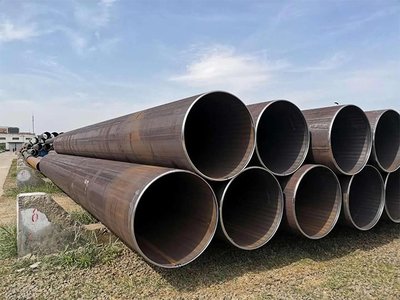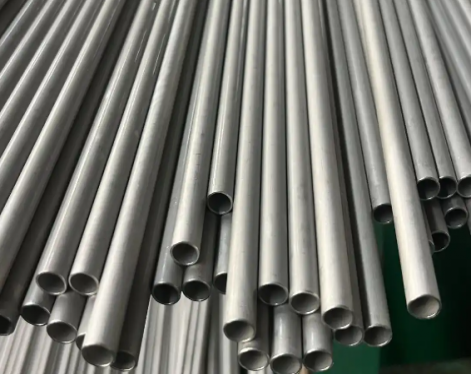1. Welded pipe installation preparation
(1) Check the drilling machine, grooving machine and pipe cutting machine to ensure safe use.
(2) Preparation of materials and tools, including pipes, steel tapes, wrenches, vernier calipers, spirit levels, lubricants, wooden hammers, scaffolding, etc.
(3) Install the support and hanger of the pipe to be installed according to the design requirements.
2. Roll groove
(1) Cut the steel pipe according to the required length with a pipe cutting machine, check the cut section with a level meter, and ensure that the cut section is perpendicular to the central axis of the steel pipe. If the incision has burrs, it should be smoothed with a grinder.
(2) Erect the steel pipe that needs to be grooved on the grooving machine and the tailstock of the grooving machine, and use a level to level it so that the steel pipe is in a horizontal position.
(3) Place the processed end section of the steel pipe close to the grooving machine so that the central axis of the steel pipe is perpendicular to the surface of the roller.
(4) Press down slowly. Jack, make the upper pressure wheel close to the steel pipe, start the grooving machine, and make the roller rotate a circle. At this time, pay attention to whether the section of the steel pipe is still close to the grooving machine. If not, adjust the pipe to the level. If it is tightly attached, slowly press down on the jack so that the upper pressure wheel rolls the steel pipe evenly to the predetermined depth of the groove.
(5) Stop the machine, check the depth and width of the groove with a vernier caliper, and after confirming that it meets the standard requirements, unload the jack and take out the steel pipe.

3. Open the hole and install the mechanical three-way and four-way
(1) Play the ink line on the steel pipe to determine the opening position of the branch pipe of the joint.
(2) Fix the chain hole opening machine at the predetermined opening position of the steel pipe.
(3) Start the motor, turn the hand wheel, and slowly approach the drill bit to the steel pipe. At the same time, add lubricant to the drill bit to protect the drill bit, and complete the hole opening on the steel pipe.
(4) Stop the machine, shake the handwheel, open the chain, remove the drilling machine, clean up the drilled metal pieces and the residue at the opening part, and use a grinder to smooth the hole.
(5) Put the clamp on the steel pipe, pay attention to that the mechanical tee should be concentric with the hole, the gap between the rubber sealing ring and the hole should be even, and the fastening bolts should be in place.
(6) If it is a mechanical four-way connection, care must be taken to ensure that the holes on both sides of the steel pipe are concentric when opening the hole. Otherwise, after the installation is completed, the rubber ring may be broken and the water passing area will be affected.
4. Pipeline installation, according to the principle of first installing large-diameter, main pipe, and standpipe, and then installing small-diameter and divided pipes. During the installation process, it must be installed continuously in order, and it is not allowed to skip or segment installation, so as to avoid connection difficulties between segments and affect the overall performance of the pipeline.
(1) Fix the steel pipe on the support and hanger, and put the non-damaging rubber sealing ring on the end of a steel pipe.
(2) Insert the other end of the steel pipe that has been coated with lubricant into the rubber sealing ring, and rotate the rubber sealing ring so that it is located in the middle of the interface.
(3) Install the upper and lower clamps on the outside of the rubber sealing ring, and send the flange of the clamp into the groove, and press the ears of the upper and lower clamps firmly. At the position of the screw hole of the clamp, install the bolts and tighten the nuts evenly in rotation. During the process of tightening the nuts, hammer the clamp with a wooden hammer to ensure that the rubber sealing ring will not wrinkle.
(4) Add supports and hangers to the 500mm inner pipeline of the rigid clamp joint.
5. After the system pressure test pipeline is installed, the system pressure test should be carried out. Before the system pressure test, it should be fully checked whether the installation parts and fixing brackets are installed in place. The installed pipe may sag. If the drooping arc is large, additional supports can be added; if the arc is small, the arc will disappear naturally when the pressure in the pipe increases.
(1) Check the drilling machine, grooving machine and pipe cutting machine to ensure safe use.
(2) Preparation of materials and tools, including pipes, steel tapes, wrenches, vernier calipers, spirit levels, lubricants, wooden hammers, scaffolding, etc.
(3) Install the support and hanger of the pipe to be installed according to the design requirements.
2. Roll groove
(1) Cut the steel pipe according to the required length with a pipe cutting machine, check the cut section with a level meter, and ensure that the cut section is perpendicular to the central axis of the steel pipe. If the incision has burrs, it should be smoothed with a grinder.
(2) Erect the steel pipe that needs to be grooved on the grooving machine and the tailstock of the grooving machine, and use a level to level it so that the steel pipe is in a horizontal position.
(3) Place the processed end section of the steel pipe close to the grooving machine so that the central axis of the steel pipe is perpendicular to the surface of the roller.
(4) Press down slowly. Jack, make the upper pressure wheel close to the steel pipe, start the grooving machine, and make the roller rotate a circle. At this time, pay attention to whether the section of the steel pipe is still close to the grooving machine. If not, adjust the pipe to the level. If it is tightly attached, slowly press down on the jack so that the upper pressure wheel rolls the steel pipe evenly to the predetermined depth of the groove.
(5) Stop the machine, check the depth and width of the groove with a vernier caliper, and after confirming that it meets the standard requirements, unload the jack and take out the steel pipe.

3. Open the hole and install the mechanical three-way and four-way
(1) Play the ink line on the steel pipe to determine the opening position of the branch pipe of the joint.
(2) Fix the chain hole opening machine at the predetermined opening position of the steel pipe.
(3) Start the motor, turn the hand wheel, and slowly approach the drill bit to the steel pipe. At the same time, add lubricant to the drill bit to protect the drill bit, and complete the hole opening on the steel pipe.
(4) Stop the machine, shake the handwheel, open the chain, remove the drilling machine, clean up the drilled metal pieces and the residue at the opening part, and use a grinder to smooth the hole.
(5) Put the clamp on the steel pipe, pay attention to that the mechanical tee should be concentric with the hole, the gap between the rubber sealing ring and the hole should be even, and the fastening bolts should be in place.
(6) If it is a mechanical four-way connection, care must be taken to ensure that the holes on both sides of the steel pipe are concentric when opening the hole. Otherwise, after the installation is completed, the rubber ring may be broken and the water passing area will be affected.
4. Pipeline installation, according to the principle of first installing large-diameter, main pipe, and standpipe, and then installing small-diameter and divided pipes. During the installation process, it must be installed continuously in order, and it is not allowed to skip or segment installation, so as to avoid connection difficulties between segments and affect the overall performance of the pipeline.
(1) Fix the steel pipe on the support and hanger, and put the non-damaging rubber sealing ring on the end of a steel pipe.
(2) Insert the other end of the steel pipe that has been coated with lubricant into the rubber sealing ring, and rotate the rubber sealing ring so that it is located in the middle of the interface.
(3) Install the upper and lower clamps on the outside of the rubber sealing ring, and send the flange of the clamp into the groove, and press the ears of the upper and lower clamps firmly. At the position of the screw hole of the clamp, install the bolts and tighten the nuts evenly in rotation. During the process of tightening the nuts, hammer the clamp with a wooden hammer to ensure that the rubber sealing ring will not wrinkle.
(4) Add supports and hangers to the 500mm inner pipeline of the rigid clamp joint.
5. After the system pressure test pipeline is installed, the system pressure test should be carried out. Before the system pressure test, it should be fully checked whether the installation parts and fixing brackets are installed in place. The installed pipe may sag. If the drooping arc is large, additional supports can be added; if the arc is small, the arc will disappear naturally when the pressure in the pipe increases.









